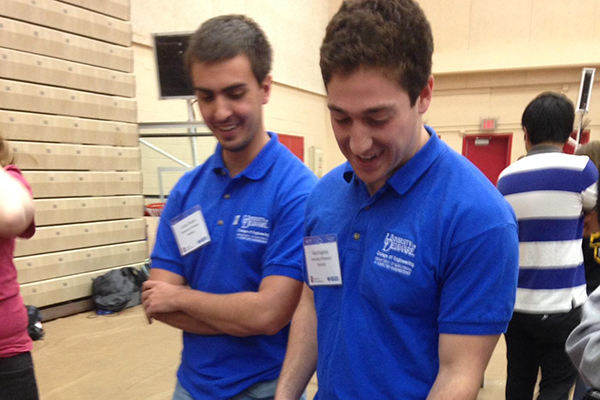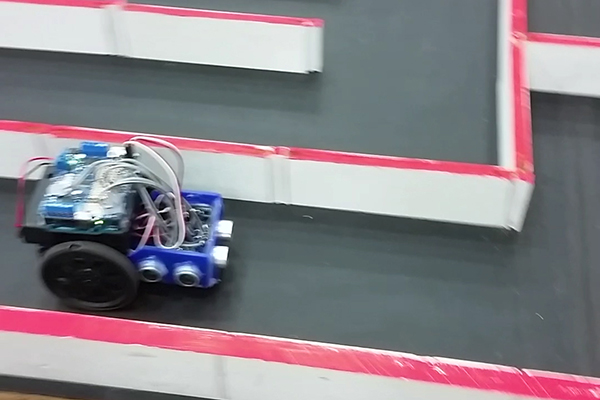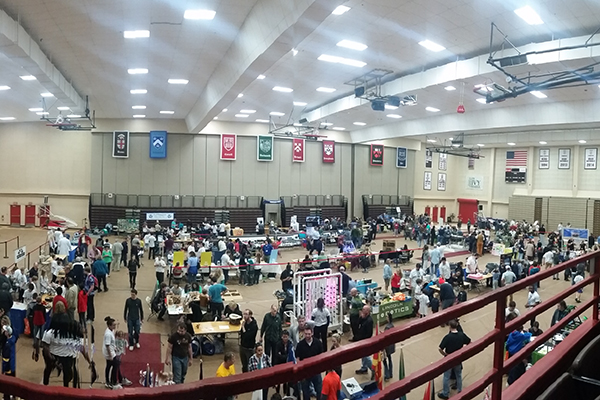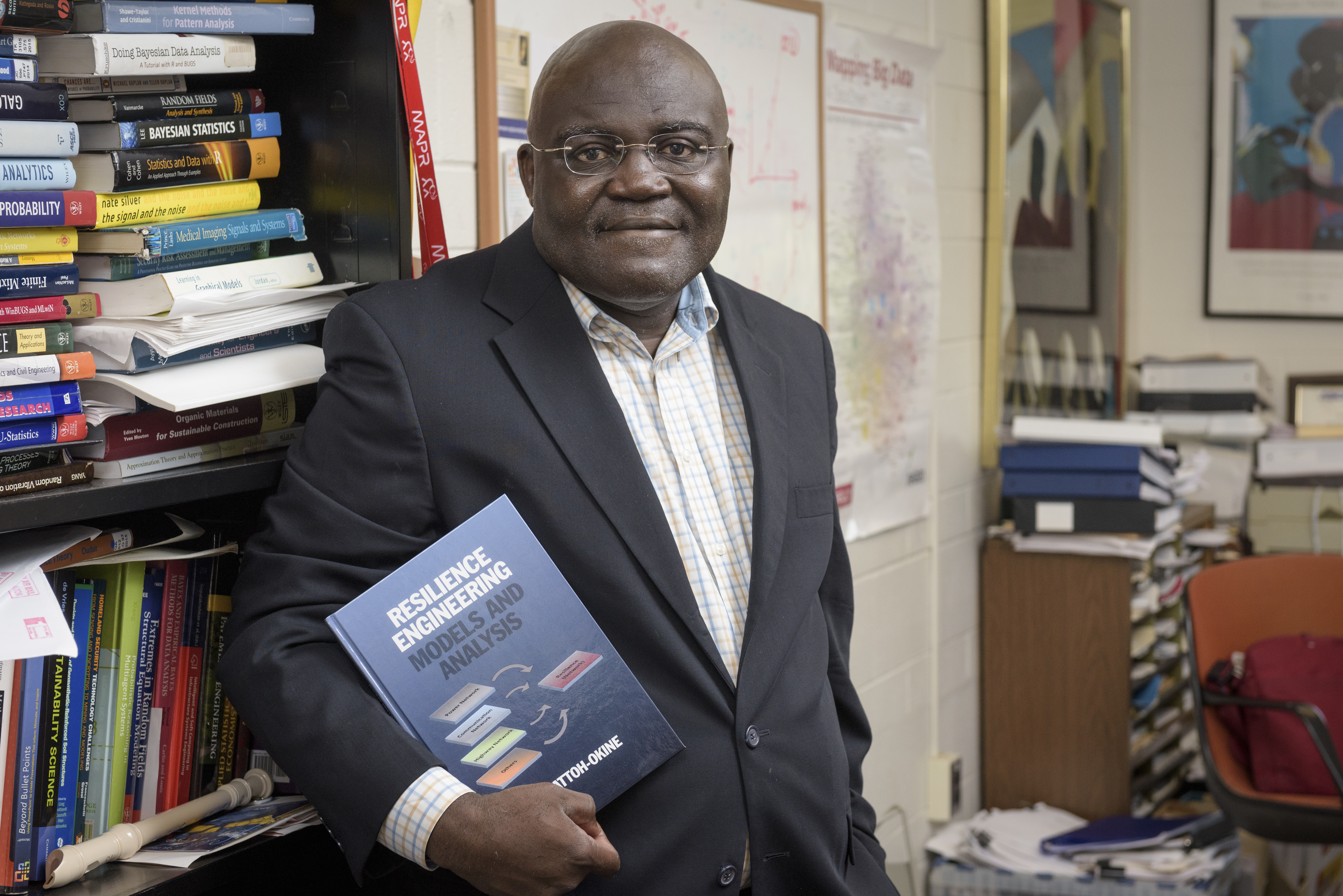Robot block party
UD's 'Brobot' competes at 2015 Brown Robotics Olympiad
2:10 p.m., May 5, 2015--Juniors Adam Engelson, an electrical engineering major, and Zachary Pearson, a computer science major, represented the University of Delaware at Brown University IEEE’s Brown Robotics Olympiad held April 11.
Teams of students from Brown, Harvard, Princeton, Yale, Lehigh, Temple, Worcester Polytechnic Institute, Union College, Rensselaer Polytechnic Institute and UD competed to design a robot that would traverse and solve a maze in the fastest time.
People Stories
'Resilience Engineering'
Reviresco June run
The competition was a featured exhibit at Rhode Island’s annual Robot Block Party. The event drew more than 2,500 people to watch the excitement of the robotics competition.
Each team was given 12 minutes to solve the 256-tile maze in the fastest time possible. If a team’s robot did not solve the maze, the number of tiles traversed in a run would be recorded for scoring.
Since January, Engelson and Pearson had been designing, building and coding their submission for the Olympiad, named the “Brobot.”
To control the Brobot, the team used the Arduino Uno, a powerful, low cost microprocessor. The Brobot used continuous Servo motors for precise, fast movements and had three ultrasonic sensors oriented on the front and sides of the robot used to detect walls for turning and keeping the robot centered while moving.
The Brobot operated on 4 AA batteries, and met all of the requirements for the competition. It cost a total of $109, which was significantly cheaper than the competition. The biggest cost of the Brobot was the cost of sleep for the two teammates.
“We had $500 to build the Brobot, but we wanted to focus on making a robot where the value was in the design, not the bill of materials,” said Engelson. “Because of this high limit, many of the teams that participated built overly complicated robots that struggled to leave the entrance of the maze. For a competition like this, the best designs are simple ones.”
Throughout March, Engelson and Pearson built a replica maze out of plastic to test the Brobot. During spring break and in early April, the team spent long nights in Spencer Lab programming and testing the Brobot on the maze they constructed.
The team faced many challenges throughout the development of the Brobot. In addition to technical troubleshooting getting the Brobot’s wiring and power management perfected, the students encountered issues that were outside of the scope of their respective majors.
To get over these hurdles, they needed to combine Engelson’s knowledge of hardware and embedded systems with Pearson’s software expertise.
“I thought this would be a quick and easy project; the problem is that the algorithms that I use as a computer scientist solve problems easily in a virtual world, but they do not translate well to the physical world,” said Pearson. “It took us several long night and many attempts just to get a robot that was able to effectively navigate a maze.”
The sensors on the Brobot were low cost, but quality was sacrificed, resulting in erroneous data acquisition. To deal with this non-ideal effect, the team processed the signals using a moving average filter. Engelson and Pearson truly formed an interdisciplinary team to successfully build the Brobot.
On April 10, they traveled to Brown University with the Brobot in the back seat. The night before the competition was mainly spent making last minute adjustments, with an hour or two of sleep to prepare the team for the long day ahead of them.
The students and the Brobot arrived at the Brown Robotics Olympiad early the following morning. They were allotted 15 minutes to calibrate the Brobot to the maze, after which they placed the Brobot among the other robots, not allowed to be touched until their run a few hours later.
When it was finally time to compete, Engelson and Pearson placed the Brobot in the starting tile, and turned it on. It worked perfectly, handling turns appropriately, and avoiding walls consistently.
Midway through its run, something went wrong that neither student expected -- there was an issue with the Brobot losing power as the batteries were drained, which caused the calibration for the turns to be unaligned.
Like a professional pit crew, they searched for a screwdriver and replaced the batteries. Unfortunately, after changing the batteries, the Brobot was no longer calibrated properly to the maze.
Although the clock ran out and the Brobot did not solve the maze in time, the team was proud of the performance of their robot, and the competition applauded.
“When it came time for our run I was nervous, but also excited,” said Pearson. “There were several teams that went before us that performed rather poorly, and I was confident that we would do better than them. When the Brobot started, it was working flawlessly; everyone was really nervous because the Brobot was much faster than the competition. It’s unfortunate that the batteries died, but we are very proud of how far we came.”
Out of the 18 teams that competed, only one team, from Brown University, was able to solve the maze. More than half of the robots were unable to make it past the first few turns, and only a couple ran for the entirety of their runs. The Brobot finished seventh out of 18 robots in the competition, beating several Ivy League teams.
Immediately after their run, Engelson and Pearson presented the Brobot at the design portion of the competition. The judges were most impressed by the optimization of the Brobot and commended the team on the low cost and impressive data structure design.
“With modern technology, memory is usually not a pressing factor when writing code,” said Engelson. “We wanted the code to reflect our ideology of keeping the robot optimized and efficient.”
Engelson and Pearson used a two-dimensional array to represent the maze, with each element containing a single byte. Each of the eight bits represented useful data, such as walls present, that were processed using bitwise operations. They used a special case of Dijkstra’s Algorithm to solve the maze.
“We used all of the skills we learned in our courses to make the best robot we could,” said Engelson. “It would not have been possible to design such an efficient robot without the knowledge learned from our professors.”
The students plan on competing again in the 2016 Brown Robotics Olympiad. They intend on working with students from UD’s IEEE and Association for Computing Machinery (ACM) chapters to ensure a victory for the Brobot next year.













